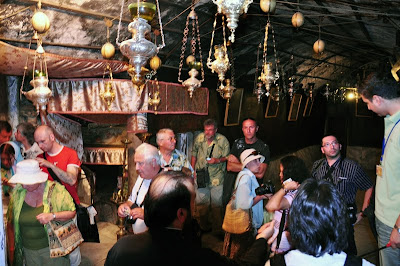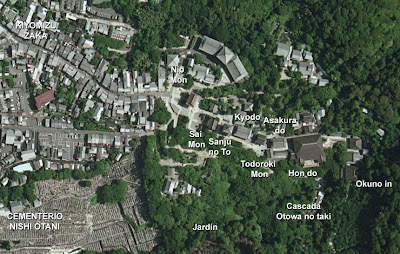
The austere and simple character of the Church of the Nativity in Bethlehem, one of the most important sites of Christianity, contrasts with the current season's paraphernalia: , awesome lighting arrangements, special decorations, giant and original trees and winter decorations (ironically,even in places like my country, wehre Chriistmas is in summer) of shopping centers in an era devoted to consumption.
I believe that the Church of the Nativity is of great importance, even if the reader is a believer or not, because of its historic architectural value (one of the oldest churches in the Byzantine style),and for being a conspicuous example of the relationship between architecture and the symbolic value of religious manifestations. This post will focus on both aspects.
 Iglesia de la Natividad en los 1920s Church of the Nativity in the 1920s
Iglesia de la Natividad en los 1920s Church of the Nativity in the 1920sABOUT BETHLEHEM
Bethlehem, Bethlehem, whose name literally means "House of Meat" is a historic city in Palestine, located about 8 km from Jerusalem, the de facto capital of Israel. Surrounded by arid hills, with typical desert climate, Bethlehem has grown into a major Palestinian city.
Bethlehem is mentioned several times in the Bible , even from the Old Testament. Formerly called Ephrata, it was there where Rachel was buried ( Genesis 35:19 ) and it was also the land of King David. Given its proximity to Jerusalem, Bethelehm was, according to the gospels, the alternative chosen by Joseph, after finding no lodging in the ancient capital of Judea.
It is ironic that in the birthplace of Christianity most people profess the Islamic religion. Bethlehem's urban landscape is more populated by minarets than by church belltowers, so we may have to update that Carol " Jingle Bells . "

Bethlehem has historically been a place for pilgrimages and religious disputes. Because of its proximity to Jerusalem, it is considered a sacred place of great importance. In fact both cities have been linked by their history, geographical setting and symbolism, recognized by three religions: Christianity, Islam and Judaism.Only recently this union between Jerusalem and Bethlehem has been fractured by the so-called "Wall of Shame", a barrier that divides Israel and Palestine and whose brutal stabbing appears as a scar on the beautiful ocher landscape of Judea.


 Come, shepherds, come, come to Bethlehem ... but first have to cross the strict and unfriendly control in the Israeli-Palestinian border.
Come, shepherds, come, come to Bethlehem ... but first have to cross the strict and unfriendly control in the Israeli-Palestinian border.CHRIST'S PLACE OF BIRTH
The Gospels of Matthew and Luke mention Jesus' birth in Bethlehem, but do not specify an exact location, even references. Only Luke wrote that Christ was born in a manger because there was no room at the inn "( Lk 2:7 ) How can we know that the church is standing on the actual birthplace of Christ?

There are two clues about that. The first one is the apocryphal Gospel of St. James , son of Zebedee, which states that Jesus was born in a cave, which makes sense since there were many caves in the area, annexed to houses, where livestock is often kept.
The second one comes from the Emperor Hadrian (76-138 AD), who had built a shrine honoring the Roman god Adonis in the cave that the early Christians venerated as the place where Jesus would be born. When they tried to suppress this new religion, in fact they underlined the place they were trying to hide (although some argue that it was the Christians who took over the temple of Adonis for his own religion).

But the truth is that there are no specific records that comfirm that this was the precise location of the birth of Christ, unlike the Golgotha in Jerusalem, which shows more clearly the place of his crucifixion. It is impossible to affirm or deny that indeed the birthplace of Christ is the one marked on the Church of the Nativity, nor is it impossible to prove that Jesus was born on December 24, but what this building means is more important than its exact geographical location or chronological accuracy. It is then that the basilica becomes important as a symbolic site and its architecture has provided a framework that marks a significant event for millions of people throughout history. In the words of Geoffrey Broadbent, the meaning becomes more important than significant.
CHURCH HISTORY
In 326, St. Helena, the mother of Emperor Constantine, ordered the construction of a church on top of the cave, culminated in 339. It was a small octagonal building with an area of 4 m in diameter in the center, where the cave revered as the birthplace of Christ was revered.
 That first church mosaics are still visible, illustrating the genealogy of Jesus as the Gospel of Matthew, as well as floral and geometric compositions.
That first church mosaics are still visible, illustrating the genealogy of Jesus as the Gospel of Matthew, as well as floral and geometric compositions.
A fire destroyed that church, so that in 530 Justinian built the current basilica. In 614 the Moors invaded and razed Bethlehem, but the church was saved. It is said that the Islamists were moved by the representation of the three wise men in Persian attire (the magi in general were followers of Zarathustra, a Persian prophet who promoted one of the oldest monotheistic religions in the world and greatly influenced Judaism during the exile in Babylon.)
The church flourished again during the invasion of the Crusaders, a time when the interior was redecorated. However, it deteriorated during the occupation of the Mamelukes and Ottomans.
Since 1852 the custody of the church is in charge of the Greek Orthodox, Roman Catholic and Armenian Church.
DISTRIBUTION
The Church of the Nativity is located atop a hill and consists, in addition to the basilica, three convents.


Opposite the church there is a large square, an atrium called the Manger Square, which is usually flooded with people during Christmas celebrations.
 The basilica itself is a rectangular building with three circular apses that give the shape of a cross. These are the main altar in the background and the altars of the Virgin and the Circumcision on the sides. Upon entering, we are received by a narthex , a sort of inner court was added after the building of the temple and in general is a transitional space between the exterior and the sacred space of the church.
The basilica itself is a rectangular building with three circular apses that give the shape of a cross. These are the main altar in the background and the altars of the Virgin and the Circumcision on the sides. Upon entering, we are received by a narthex , a sort of inner court was added after the building of the temple and in general is a transitional space between the exterior and the sacred space of the church.
A curious detail is that entrance is a small opening, called the Door of Humility. Formerly in Byzantine times the entry was an arcade, but during Ottoman times the entrance was reduced to prevent the infidels from entering the church horse.

Inside, the nave is divided into five islands defined by 4 rows of 11 columns each.The height of the main space suggests a monumental space while allowing the entry of light, while the lateral spaces offer a more intimate experience, ideal to the prayers of pilgrims.

The columns are decorated with figures of saints, made in the twelfth century during the rule of the Crusaders, but are darkened by the passage of time. Some of the figures include those of canonized kings, like St. Canute, king of England in 1017 and St. Olaf, King of Norway in 1016. Furthermore, in the lower parts of the columns there are many graffiti, made by pilgrims over the centuries.
The wooden roof corresponds to the fifteenth century and originally was covered with lead, both donated by King Edward IV of England. Unfortunately the lead was cast by the Turks to make munitions during their war against the Venetians, and today the roof is in poor condition.


Since it is an Orthodox church, it is noticeable the presence of an iconostasis , a wall decorated with icons, located opposite the altar.


But undoubtedly the most important element of the church on the Grotto of the Nativity, located behind the altar and is in charge of the Orthodox Church. Some semicircular stairs give way to a narrow passage.

 Given the large number of pilgrims, visiting the cave lasts just seconds, maybe a minute, before an Orthodox priest hurried us out.
Given the large number of pilgrims, visiting the cave lasts just seconds, maybe a minute, before an Orthodox priest hurried us out.Inside, in a marble-covered space, a silver star is located, marking the spot where it says Jesus was born, and bearing the inscription Hic Virgine Maria Jesus Christus natus est.

 In 1853 the theft of the Silver Star was an important factor in the outbreak of the Crimean War , between France, the Ottomans and Russia.
In 1853 the theft of the Silver Star was an important factor in the outbreak of the Crimean War , between France, the Ottomans and Russia. Other outbuildings include the Chapel of St. Jerome, who was the one who translated the Old Testament into Latin, and the church of Santa Catalina, ruled by Catholics.
 This bas-relief called The Tree of Jesse is the work of Polish sculptorCzesław Dźwigaj and located in the Church of Santa Catalina, which was a gift from Pope Benedict XVI during his visit to the Holy Land.
This bas-relief called The Tree of Jesse is the work of Polish sculptorCzesław Dźwigaj and located in the Church of Santa Catalina, which was a gift from Pope Benedict XVI during his visit to the Holy Land. 












































